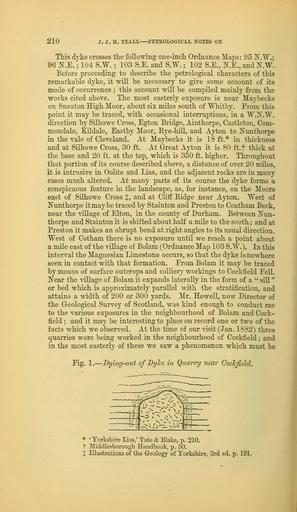MAKE A MEME
View Large Image

| View Original: | The_Quarterly_journal_of_the_Geological_Society_of_London_(14076271574).jpg (1204x2076) | |||
| Download: | Original | Medium | Small | Thumb |
| Courtesy of: | commons.wikimedia.org | More Like This | ||
| Keywords: The Quarterly journal of the Geological Society of London (14076271574).jpg 210 J J H TEAUL PETEOLOGICAL 'OIES ON <br> This dvke crosses the following one-inch Ordnance lEaps 95 X W ; <br> 96 E ˘ 104 S W ; 103 S E and S W ; 102 S E X E and X W <br> Before proceeding to describe the peti'ological characters of this <br> remarkable dyke it will be necessary to give some account of its <br> mode of occurrence ; this account will be compiled mainly from the <br> works cited above The most easterly exposure is near Maybecks <br> on Sneaton High lEoor about six miles south of Whitby Prom this <br> point it may be traced with occasional interruptions in a W X W <br> direction by Silhowe Cross Egton Bridge Ainthorpe Castleton Com- <br> mondale Kildale Eastby Moor Eye-hiU and Ayton to Xunthorpe <br> in the Tale of Cleveland At Maybecks it is 18 ft in thickness <br> and at Silhowe Cross 30 ft At Great Ayton it is 80 ft f thick at <br> the base and 20 ft at the top which is 350 ft higher Throughout <br> that portion of its course described above a distance of over 20 miles <br> it is intrusive in Oolite and Lias and the adjacent rocks are in many <br> cases much altered At many parts of its course the dyke forms a <br> conspicuous feature in the landscape as for instance on the floors <br> east of Silhowe Cross i and at Cliff Eidge near A -ton West of <br> f7unthorpe it may be traced by Stainton and Preston to Coatham Beck <br> near the village of Elton in the county of Durham Between Xun- <br> thorpe and Stainton it is shifted about half a mile to the south ; and at <br> Preston it makes an abrupt bend at right angles to its usual direction <br> TTest of Cotham there is no exposure until we reach a point about <br> a mile east of the village of Bolam Ordnance Map 103 S W In this <br> interval the Magnesian Limestone occurs so that the dyke is nowhere <br> seen in contact with that formation Prom Bolam it may be traced <br> by means of surface outcrops and colliery workings to Cockfield PeU <br> iNear the village of Bolam it expands laterally in the form of a sill <br> or bed which is approximately parallel with the stratification and <br> attains a width of 200 or 300 yards Mr Howell now Director of <br> the G-eological Survey of Scotland was kind enough to conduct me <br> to the various exposures in the neighbourhood of Bolam and Cock- <br> field ; and it may be interesting to place on record one or two of the <br> facts which we observed At the time of our visit Jan IS 82 three <br> quarries were being worked in the neighbourhood of Cockfield ; and <br> in the most easterly of these we saw a phenomenon which mnst be <br> Pig 1 ” Dying-out of By he in Quarry near Cockfield <br> ' Yorkshire Lias ' Tate Elate p 210 <br> t Middlesborough Handbook p 50 <br> I lUustrations of the Geology of Yorkshire 3rd ed p 191 36940999 113697 51125 Page 210 Text 40 http //www biodiversitylibrary org/page/36940999 1884 Geological Society of London Biodiversity Heritage Library The Quarterly journal of the Geological Society of London v 40 1884 Geology Periodicals Smithsonian Libraries bhl page 36940999 dc identifier http //biodiversitylibrary org/page/36940999 smithsonian libraries Information field Flickr posted date ISOdate 2014-04-30 Check categories 2015 August 26 CC-BY-2 0 BioDivLibrary https //flickr com/photos/61021753 N02/14076271574 2015-08-26 05 56 10 cc-by-2 0 PD-old-70-1923 The Quarterly journal of the Geological Society of London 1884 Photos uploaded from Flickr by Fæ using a script | ||||